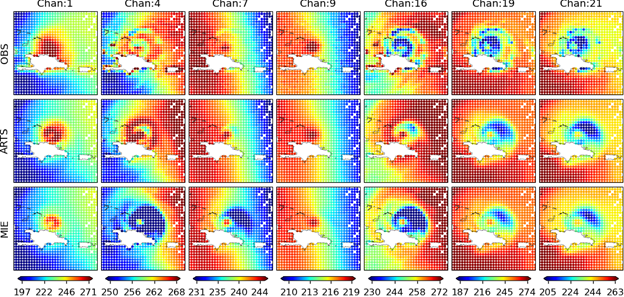ESSIC/CISESS Scientist Isaac Moradi has a new article from his JPSS PGRR and NASA MAP projects coming out in the December 27th issue of the Journal of Geophysical Research: Atmospheres.
The Community Radiative Transfer Model (CRTM) is a fast model developed by NOAA Center for Satellite Applications and Research (STAR)/Joint Center for Satellite Data Assimilation (JCSDA) and widely used for different purposes requiring radiative transfer calculations. CRTM requires bulk scattering lookup tables in order to perform all-sky radiative transfer (RT) calculations. The current CRTM lookup tables for microwave frequencies were generated based on the Mie theory by assuming spherical frozen particles, while such hydrometeors have different irregular shapes in the real world. The scattering lookup tables generated using the Discrete Dipole Approximation (DDA) technique have been shown to largely improve the RT scattering calculations in the microwave region. The goal of this project includes generating CRTM cloud lookup tables using the DDA technique then evaluating the impact of the new lookup tables on the assimilation of microwave observations into NOAA FV3 model.

Figure 1 shows the CRTM simulated brightness temperatures using Mie and DDA cloud coefficients versus ATMS observed values over Hurricane Irma on September 7, 2017 at 18:00 UTC. The DDA/ARTS simulations for channels 1-7 largely perform better than the Mie simulations. The DDA simulations show a mix of small negative and positive simulated minus observed values, while the Mie results show large negative biases. The weighting functions for some of the ATMS temperature sounding channels (channels 9-15) peak mostly above the clouds, therefore the measured brightness temperatures (Tbs) become less sensitive to clouds so that the results of both Mie and DDA become very similar. The Mie lookup tables generate excessive scattering for channel 16, but not enough scattering for the water vapor channels.
Moradi joined Earth System Science Interdisciplinary Center (ESSIC), University of Maryland in 2011. His research is focused on microwave remote sensing including, calibration and validation of satellite microwave observations, retrieving geophysical variables from satellite microwave measurements, microwave radiative transfer modeling, assimilation of all-sky microwave observations into NWP models, and Observing System Simulation Experiments (OSSE). He is affiliated with NASA Global Modeling and Assimilation Office (GMAO) and NOAA Center for Satellite Applications and Research (STAR).
To access the article, click here: “Implementation of a Discrete Dipole Approximation Scattering Database Into Community Radiative Transfer Model”.






